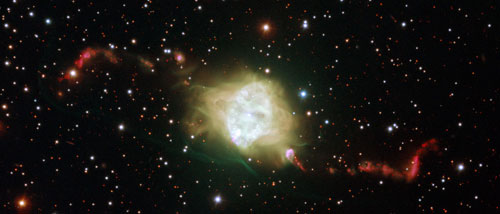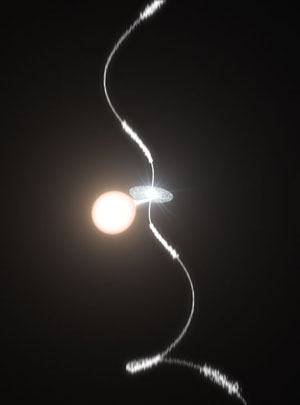Planetary nebulae, left behind by stars like our Sun, come in chimerical shapes. New observations confirm that many of these shapes may have a common explanation.

The ESO's Very Large Telescope captured this image of planetary nebula Fleming 1. Inside the glowing gas cocoon, a pair of stars whirl around each other every 1.2 days. The interaction between the two stars creates the nebula's S-shaped symmetry.
ESO / H. Boffin
Do not go gentle into that good night,
Old age should burn and rave at close of day;
Rage, rage against the dying of the light.
— Dylan Thomas
Dying stars seem to pay heed to poetry. When stars roughly the mass of the Sun near the end of their lives, they shed their outer layers like trees in autumn. The glowing gas shells, called planetary nebulae, come in a colorful variety of shapes. The spectacular structures are all the more mysterious because stars are largely spherical. Determining how these shapes form used to be a matter of fierce debate, but one now-mainstream theory has found firm footing in a study published in today’s Science.
Henri Boffin (European Southern Observatory, Chile) and his colleagues present new observations taken with ESO’s Very Large Telescope of Fleming 1, a butterfly-shaped planetary nebula renowned for its spectacular set of S-shaped jets. The jets shoot out in two arcs from the dying star at the nebula’s center. Theorists have long suggested the presence of a second star might explain such jets’ characteristic shape. Observations carried out by Boffin’s team confirm this theory with definitive evidence of not one but two stars in the nebula’s heart, whipping around each other every 1.2 days.
In an unusual twist, both stars are white dwarfs, the glowing cinders of what were once Sunlike stars. The two stars might initially have been similar in size, evolving to the white dwarf phase one right after the other — a rare occurrence in planetary nebulae. The stars currently weigh 0.5 to 0.86 and 0.7 to 1.0 times the mass of the Sun, where the ranges reflect the errors associated with the mass measurements.
The more massive star was likely responsible for the S-shaped jets, which span 9 light-years from tip to tip. Symmetrical knots line both jets, suggesting episodic activity between 16,000 years ago — about the time when humans crossed the Bering Strait from Asia to North America — and 6,000 years ago.

This artist's illustration demonstrates how interaction between two stars can create an S-shape to the jets. The white dwarf in this image is feeding off the red giant's stellar wind, and the whirling buffet of gas wobbles in response to the two stars' close orbit, creating bipolar jets that wobble too.
ESO / L. Calçada
Theorists have argued for 30 years that a binary would best explain the jets’ kinks. First, the smaller star blew a stellar wind, which the larger star gathered into a whirling cloak of gas called an accretion disk. When the companion’s tight orbit caused it to “bump” the cloak, the whole thing wobbled like a spinning top. The jets, powered by the disk, wobbled too. Once the disk grew too large, it engulfed both stars in a “common envelope,” cutting off accretion to the larger star.
The discovery of the binary system in Fleming 1 cements this theory. Not only that, but the team also discovered a ring of bright knots surrounding the stars in their plane of orbit, which might also have resulted from interaction in the binary system.
“It took more than a decade, sometimes with fierce fighting, to convince the planetary nebula community that single stars cannot lead to such morphologies,” says Noam Soker (Technion – Israel Institute of Technology), who was not involved in the study.
“This finding puts the binary model on very strong ground, such that it should go beyond the planetary nebula community,” Stoker suggests. “The shaping of planetary nebulae is at the crossroads of many astrophysical objects, from core collapse supernovae to clusters of galaxies.”
Boffin and his colleagues agree — the conclusion of the paper relates Fleming 1 to other planetary nebulae such as the Necklace Nebula, but they don’t stop there. Similar structures can be found in systems that have nothing to do with planetary nebulae. Supernova 1987A, for example, formed a knotty ring structure about 30,000 years before it blew up, although observations have been unable to distinguish whether that particular exploding star had a companion. And symbiotic stars and massive stars sometimes fling out S-shaped jets. Though it’s too soon to draw definitive conclusions, binary interaction may be the common thread that binds these disparate systems.
 3
3
Comments
Peter
November 9, 2012 at 9:14 am
The description is really confusing. Two white dwarfs? I thought planetary nebulas formed in the process of a star becoming a white dwarf. One star was already a white dwarf? “First, the smaller star blew a stellar wind, which the larger star gathered into a whirling cloak of gas called an accretion disk.” Okay…but the artist's illustration shows the larger star blowing, and the small one accreting.
You must be logged in to post a comment.
Matthew
November 9, 2012 at 1:36 pm
@Peter: You have to understand how stars evolve. Larger mass stars age faster than do lower mass stars. So in this case, the larger mass star has already gone through its red giant stage and left behind a white dwarf. Now the other star has evolved into a giant and is shedding its atmosphere, the white dwarf from the more massive star is pulling some of the material in. This is the same process that causes nova and type 1A supernovae in more massive pairs of stars but on a smaller scale.
You must be logged in to post a comment.
Monica Young
November 9, 2012 at 1:45 pm
Hi Peter - Matthew answered your question pretty well, I think, but I think part of the confusion may have resulted from my choice of words. I wrote "the larger star" when I should have written "the more massive star." The white dwarf in the artist's illustration is indeed smaller in size than the red giant, but it's more massive, which (as Matthew said) is why it evolved to the white dwarf phase first. I've changed the text to clarify this. Thanks for asking the question!
You must be logged in to post a comment.
You must be logged in to post a comment.